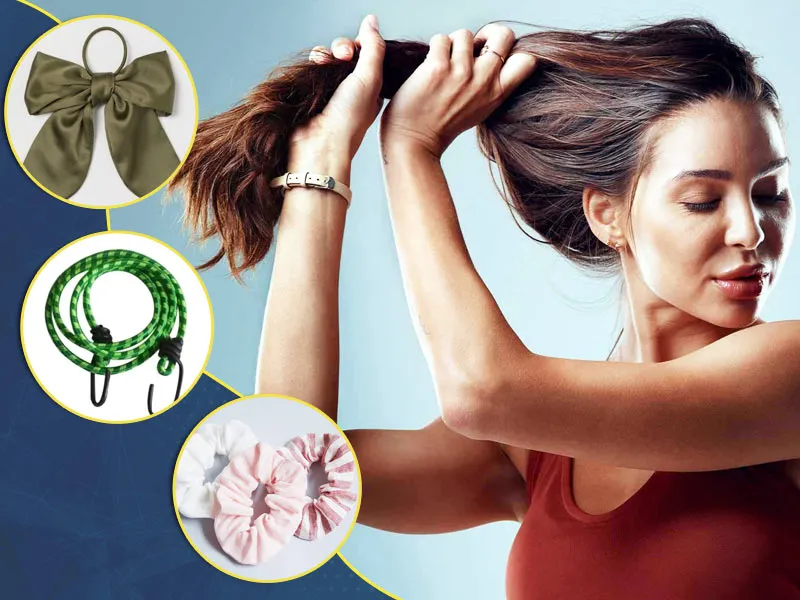
Hair ties are a daily essential for most females, whether they’re heading to the gym, working from home, or styling a slick back bun. But what if something as harmless-looking as a hair tie is secretly damaging your hair? According to dermatologists and trichologists, the improper use of hair accessories or improper tying habits can lead to breakage, thinning, and even traction alopecia over time.
Table of Content:-
So, the editorial team of Onlymyhealth reached out to their expert, Dr Kriti Lohia, CEO & Consultant Dermatologist, MBBS, DDVL, DABRM, Aesthetics Redefined by Cocoona Clinic - Gurgaon, and she helped us to determine if you should really stop making this mistake. Read ahead to find out.
How Hair Ties Cause Damage
“Although hair-tying in itself is not detrimental, tension and friction are the greatest breakage culprits,” Dr Lohia said. Here's why:
1. Elastic Friction
Classic rubber-band type ties pull on the cuticle of the hair. The rough nature rubs against the shaft, which leads to fraying and split ends.
Also Read: Want A Glowing Skin Like Sara Tendulkar? Here Is What She Follows and You Can Have It Too!

2. Ongoing Tension
Tying hair too tightly pulls on the roots and destroys follicles. This tension can break hair and may result in long-term thinning around the crown and hairline.
3. Repeated Stress in One Area
Wearing a ponytail or bun in the same spot daily creates weak points. Hair can become brittle and eventually break mid-length.
4. Wet Hair Trouble
Hair is naturally more fragile when wet. Tying damp hair can lead to stretching and snapping.
Signs Your Hair Tie Is Damaging Your Hair
Dr Lohia noted that if you’re noticing any of these, hair ties could be to blame:
- Short, broken strands around the hairline or nape
- Ponytail denting and folding
- Flyaways or frizz spots
- Soreness or tenderness on the scalp
- Slow thinning around bound areas
Also Read: Expert Shares You Should Have 1 Fruit Everyday At 4pm, Here's Why

Safer Alternatives to Conventional Hair Ties
Dr Lohia suggested replacing conventional hair ties with tender, hair-friendly alternatives that reduce friction and pulling. These may include:
- Silk or Satin Scrunchies: The smooth texture avoids snagging and cuticle irritation.
- Coil (Telephone Cord) Hair Ties: Their curved design spreads pressure uniformly.
- Soft Fabric Hair Bands: Cotton or microfibre bands without metal clasps are easier on strands.
- Claw Clips: Good for taking tension altogether down, particularly during work or unwinding.
Healthy Hair-Tying Habits
“It's not what you use, it's how you use it,” Dr Lohia emphasised. Follow these expert-approved tips to keep breakage at bay:
1. Avoid Tight Hairstyles
If your scalp hurts or feels tight, the style is too harsh. Looser buns and low ponytails are good alternatives.
2. Switch Up Your Style
Switch the location of your ponytail or bun every day to avoid excessive strain on the same spot.
3. Never Use Rubber Bands
Rubber bands are your hair's worst enemies, as they tug at the shaft of the hair, resulting in extreme breakage.
4. Don't Tie Wet Hair
Always prioritise air or towel-drying the hair roughly before tying it into a bun or pony.
5. Moisturise and Protect
Conditioned hair breaks less. Leaving a leave-in serum or oil on points where it's tied up creates a protective barrier.
6. Take Hair Breaks
Leaving your hair down as much as possible decreases traction and enhances scalp circulation.
“If hair ties have already resulted in visible harm, such as edges that thin, patches of short hair, or tenderness, the first thing is to eliminate tight styles. A dermatologist or trichologist can check you out for traction alopecia, which is a hair-pulling condition on the hair follicles over time. Early alterations are reversible, but constant stress is a permanent cause of damage,” Dr Lohia concluded.
This doesn't mean that you have to completely avoid tying your hair up; just be careful. The proper accessories, healthy hair, and no tight style all the time can greatly minimise risks.
Bottomline
Our hair tie is tiny, but the damage that can be done to your hair over time is not. Changing to softer materials and tension-free styles can save your hair from unnecessary breakage.
Also watch this video
FAQ
1. What hair ties are best to avoid breakage?
Scrunchies from silk or satin, coil ties, and soft fabric bands with no metal clasps are the safest.2. Will tying wet hair damage it?
Yes. Wet hair is more elastic and weaker, so it stretches and snaps when tied.3. How tight is too tight for a ponytail?
If it causes discomfort, scalp tenderness, or leaves a dent after removal, it’s too tight and should be loosened.
How we keep this article up to date:
We work with experts and keep a close eye on the latest in health and wellness. Whenever there is a new research or helpful information, we update our articles with accurate and useful advice.
Current Version
Oct 16, 2025 17:31 IST
Published By : Tanya Srivastava